Need Help Solving Those Dreaded Word Problems Involving Quadratic Equations?
Yes, I know it's tough. You've finally mastered factoring and using the quadratic formula and now you are asked to solve more problems!
Except these are even more tough. Now you have to figure out what the problem even means before trying to solve it. I completely understand and here's where I am going to try to help!
There are many types of problems that can easily be solved using your knowledge of quadratic equations. You may come across problems that deal with money and predicted incomes (financial) or problems that deal with physics such as projectiles. You may also come across construction type problems that deal with area or geometry problems that deal with right triangles.
Lucky for you, you can solve the quadratic equations, now you just have to learn how to apply this useful skill.
On this particular page, we are going to take a look at a physics "projectile problem".
Projectiles - Example 1
A ball is shot from a cannon into the air with an upward velocity of 40 ft/sec. The equation that gives the height (h) of the ball at any time (t) is: h(t)= -16t2 + 40ft + 1.5. Find the maximum height attained by the ball.
Let's first take a minute to understand this problem and what it means. We know that a ball is being shot from a cannon. So, in your mind, imagine a cannon firing a ball. We know that the ball is going to shoot from the cannon, go into the air, and then fall to the ground.
So, here's a mathematical picture that I see in my head.
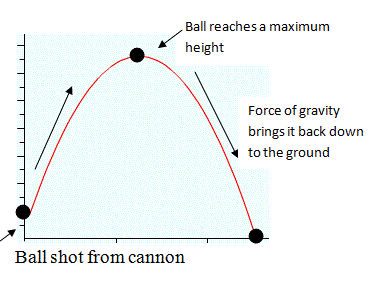
Now let's talk about what each part of this problem means. In our equation that we are given we must be given the value for the force of gravity (coefficient of t2). We must also use our upward velocity (coefficient of t) and our original height of the cannon/ball (the constant or 1.5). Take a look...
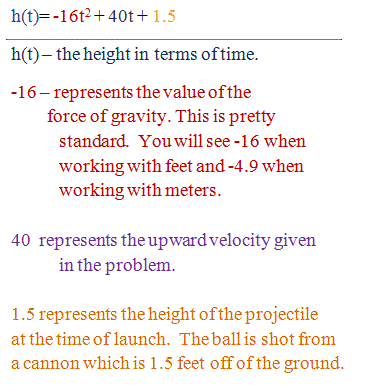
Now that you have a mental picture of what's happening and you understand the formula given, we can go ahead and solve the problem.
- First, ask yourself, "What am I solving for?" "What do I need to find?"
You are asked to find the maximum height (go back and take a look at the diagram). What part of the parabola is this? Yes, it's the vertex! We will need to use the vertex formula and I will need to know the y coordinate of the vertex because it's asking for the height. - Next Step: Solve! Now that I know that I need to use the vertex formula, I can get to work.
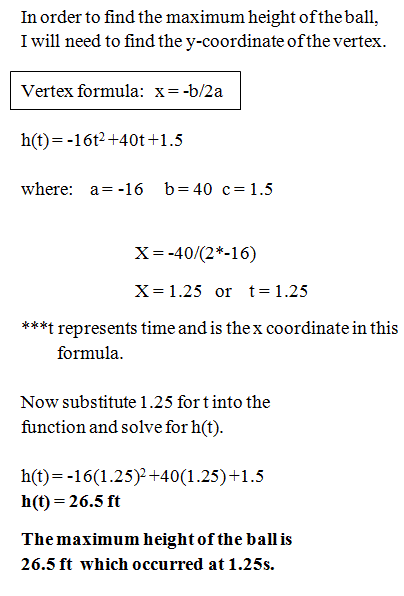
Just as simple as that, this problem is solved.
Let's not stop here. Let's take this same problem and put a twist on it. There are many other things that we could find out about this ball!
Projectiles - Example 2
Same problem - different question. Take a look...
A ball is shot from a cannon into the air with an upward velocity of
40 ft/sec. The equation that gives the height (h) of the ball at any
time (t) is:
h(t)= -16t2 + 40ft + 1.5. How long did it take for the ball to reach the ground?
Now, we've changed the question and we want to know how long did it take the ball to reach the ground.
What ground, you may ask. The problem didn't mention anything about a ground. Let's take a look at the picture "in our mind" again.
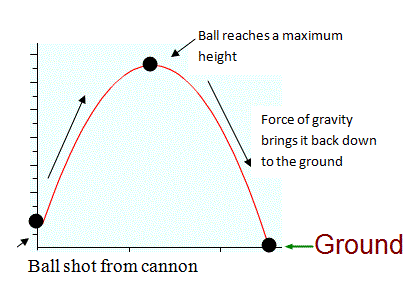
Do you see where the ball must fall to the ground. The x-axis is our "ground" in this problem. What do we know about points on the x-axis when we are dealing with quadratic equations and parabolas?
Yes, the points on the x-axis are our "zeros" or x-intercepts. This means that we must solve the quadratic equation in order to find the x-intercept.
Let's do it! Let's solve this equation. I'm thinking that this may not be a factorable equation. Do you agree? So, what's our solution?
Hopefully, you agree that we can use the quadratic formula to solve this equation.
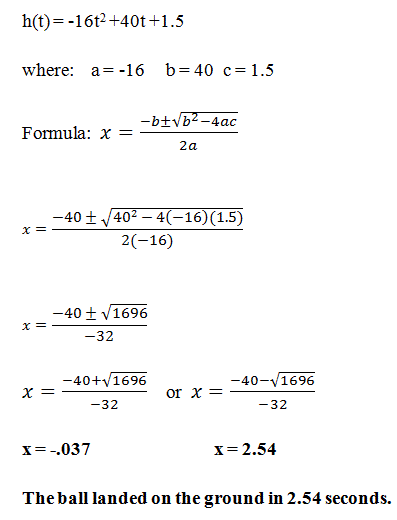
The first time doesn't make sense because it's negative. This is the calculation for when the ball was on the ground initially before it was shot.
This actually never really occurred because the ball was shot from the cannon and was never shot from the ground. Therefore, we will disregard this answer.
The other answer was 2.54 seconds which is when the ball reached the ground (x-axis) after it was shot. Therefore, this is the only correct answer to this problem.
Ok, one more spin on this problem. What would you do in this case?
Projectiles - Example 3
A ball is shot from a cannon into the air with an upward velocity of 40
ft/sec. The equation that gives the height (h) of the ball at any time
(t) is:
h(t)= -16t2 + 40ft + 1.5.
How long does it take the ball to reach a height of 20 feet?
Yes, this problem is a little trickier because the question is not asking for the maximum height (vertex) or the time it takes to reach the ground (zeros), instead it it asking for the time it takes to reach a height of 20 feet.
Since the ball reaches a maximum height of 26.5 ft, we know that it will reach a height of 20 feet on the way up and on the way down.
Let's just estimate on our graph and also make sure that we get this visual in our head.
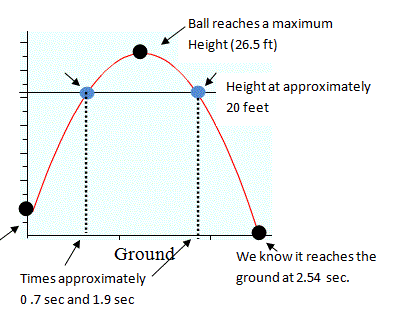
From looking at this graph, I would estimate the times to be about 0.7 sec and 1.9 sec. Do you see how the ball will reach 20 feet on the way up and on the way down?
Now, let's find the actual values. Where will we substitute 20 feet?
Yes, we must substitute 20 feet for h(t) because this is the given height. We will now be solving for t using the quadratic formula. Take a look.
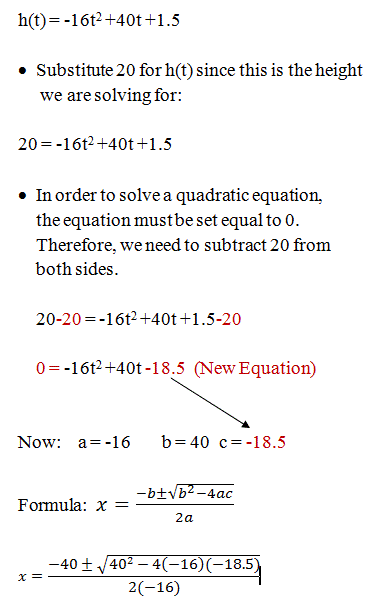
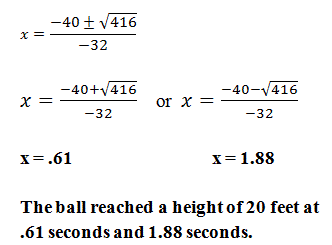
Our actual times were pretty close to our estimates. Just don't forget that when you solve a quadratic equation, you must have the equation set equal to 0. Therefore, we had to subtract 20 from both sides in order to have the equation set to 0.
You've now seen it all when it comes to projectiles!
Great Job! Hopefully you've been able to understand how to solve problems involving quadratic equations. I also hope that you better understand these common velocity equations and how to think about what this problem looks like graphically in order to help you to understand which process or formula to use in order to solve the problem.

Need More Help With Your Algebra Studies?
Get access to hundreds of video examples and practice problems with your subscription!
Click here for more information on our affordable subscription options.
Not ready to subscribe? Register for our FREE Pre-Algebra Refresher course.





Comments
We would love to hear what you have to say about this page!